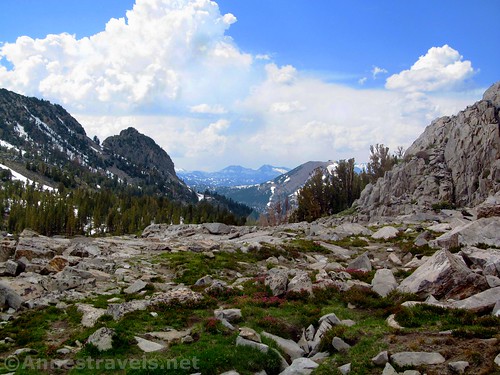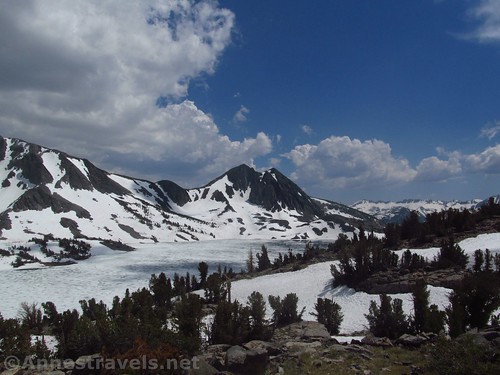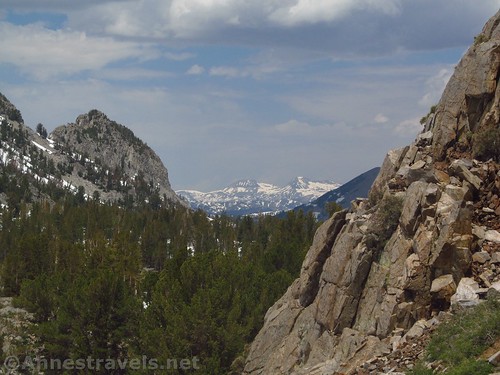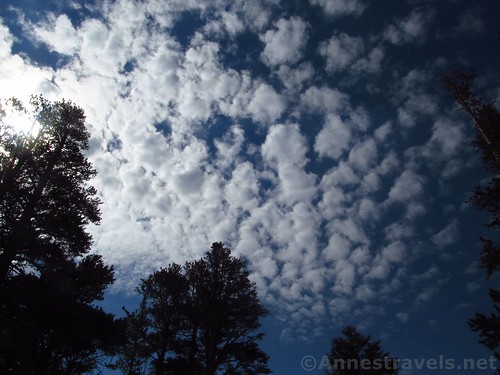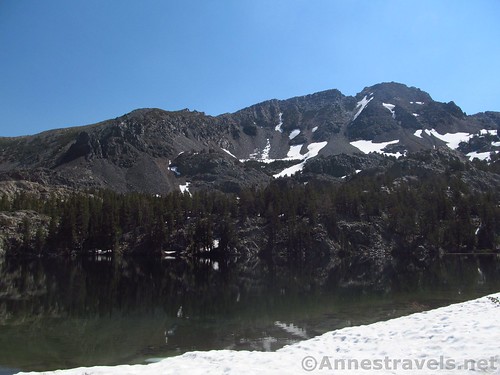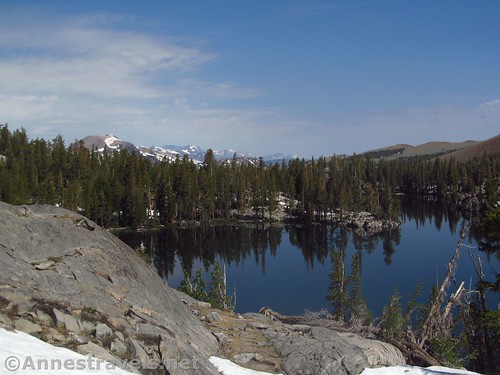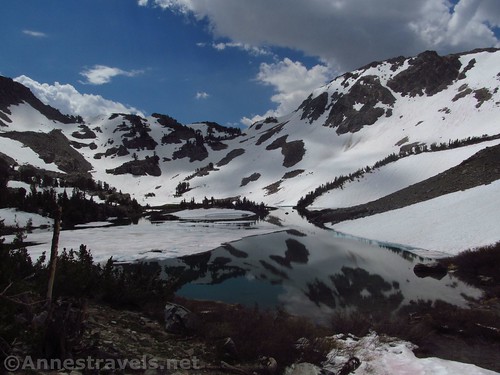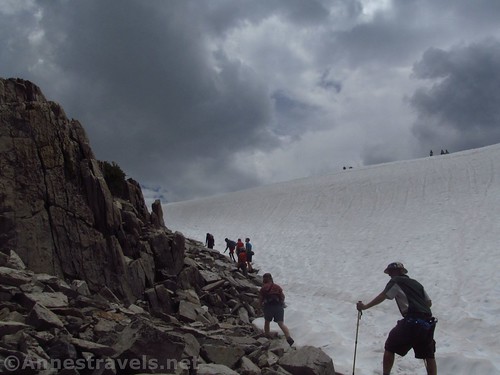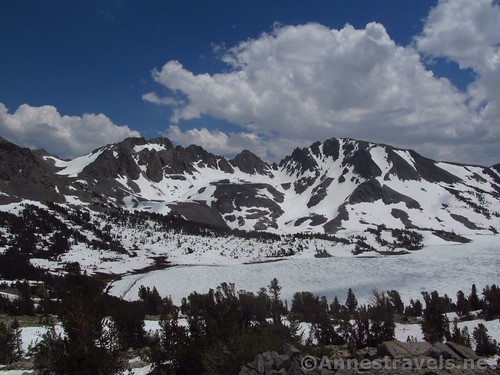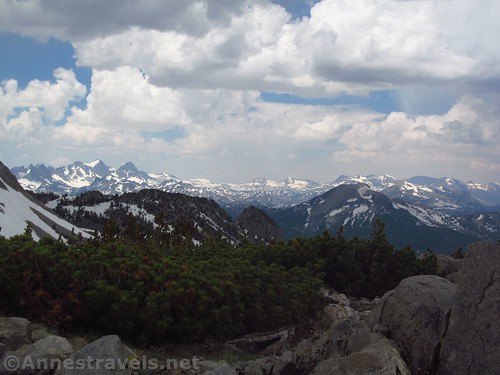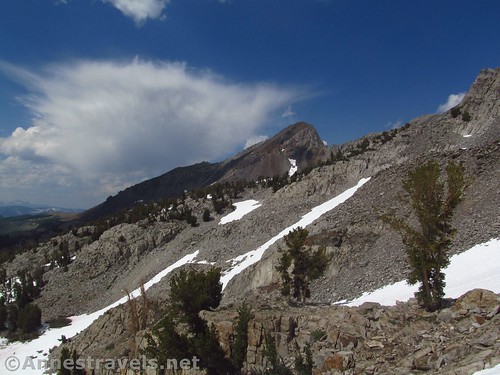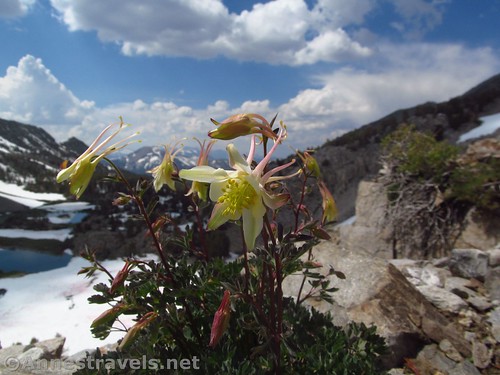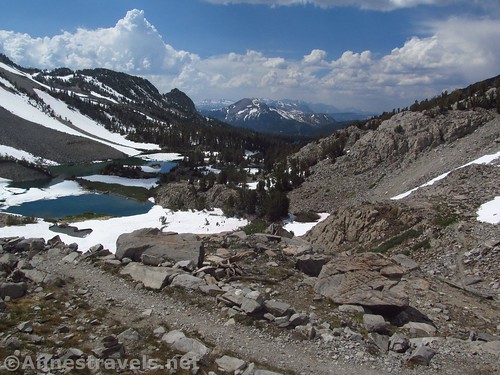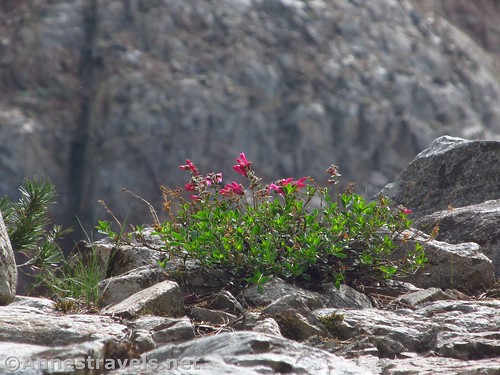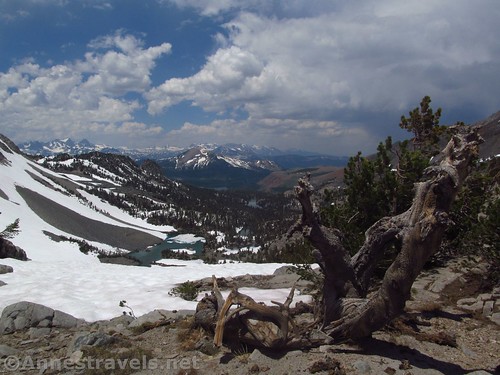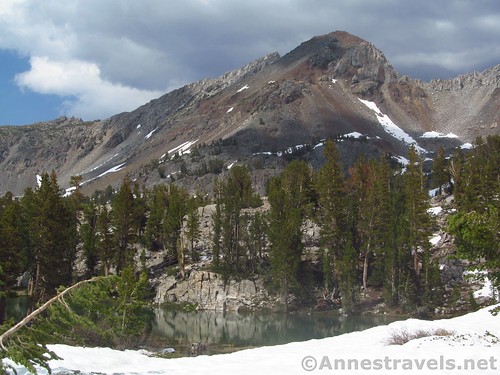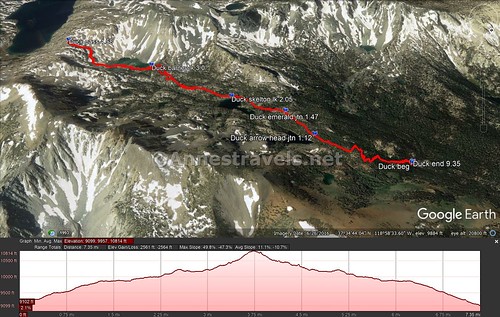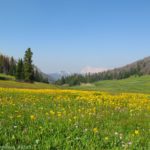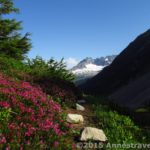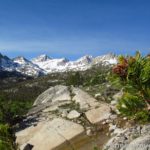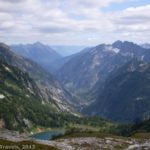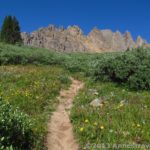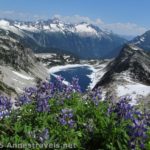If you can do one trail near Mammoth Lakes, CA, Duck Pass certainly should rank high on your list of possibilities. The trail passes by several lakes between mountains before ascending to an 10,800ft. pass overlooking the valley you just hiked through, numerous peaks of the High Sierras, and the 222 acre Duck Lake, with more peaks beyond. To say it is beautiful is almost an understatement; it is absolutely stunning!
Quick Stats
I had actually wanted to hike San Joaquin Mountain that day, but the road was still snowed in; we saw the equipment out plowing the road clear. That should have been an indication of what was to come at Duck Pass, but we had hiked in Yosemite for the past week, and then summited Mono Pass the day before, so we weren’t too worried about the snow.
Of course, we weren’t counting on the fact that my GPS didn’t show the trail. But hey, what’s a hike without an adventure?
The trail starts off somewhat flat, but quickly begins to gain elevation. We found some snow here, but nothing to turn us off (expert trail-finders that we were at that point, right? Which is how the two groups of us got separated without any snow at all, took two different trails to the same place, and then waited for 20 minutes for the slower group to arrive when they had taken a shortcut and were ahead of us…)
The trail to Arrowhead Lake diverges to the left after 1.1 miles, then the trail to Emerald Lake diverges from the right at mile 1.4. Stay on the main trail (right at the first junction, left at the second).
After the Emerald Lake junction, the trail begins to (generally) follow Mammoth Creek southward. Views open up slightly, but quite honestly, we lost the trail in this section because of the snow. That’s when I discovered that the trail wasn’t marked on my GPS, and also when another intrepid hiker from SoCal declared, “I’m going to stay close to you, because you have a GPS!” Thanks. I hope I don’t lead you into a mess!
Reach Skelton Lake at mile 2.0; continue along it and (for us, through more snow) to Barney Lake at mile 3.0. The trail traverses its eastern shores before heading upward in earnest.
Now, the problem was that we could see the switchbacks. That wasn’t a problem, but the switchbacks disappeared into massive snowfields, and we couldn’t tell where the trail went from there. The problem with that was that there were about three passes at the end of the valley, and we weren’t sure which one was Duck Pass. My GPS wasn’t even particularly helpful.
Up and up, we skidded on the snow, took pictures of wildflowers, and generally hoped we were going in the right direction. I gave up on trying to figure out which was right and let another group member pick our route while I stayed back and helped the less-agile members of the group across the extremely steep sections. Behind us, the man who liked my GPS was still following a short ways behind.
At 4.5 miles from the trailhead, we finally crested Duck Pass. It really was the pass, too, we could see now – not that we could see the trail. But below us was Duck Lake, and the views were absolutely stunning.
Duck Lake looked more like a 222 acre skating rink than a lake, but the extra snow was stunning on the surrounding mountains. Behind us, views extended to snow-speckled mountains far away, even into Yosemite National Park. Beautiful!
A few minutes later, the group that had been tangentially following the lady with the GPS came up behind us. But there was plenty of room for both of us in the pass, and we all had a snack and waited for the one member of their group who had decided to scramble down to Duck Lake. He came back just before we headed back down, and probably 10 minutes after the rest of his group decided to get a head start back to the parking area.
On the way back, we met another group from New York, and another from Ohio who was hiking with a cousin (?) from California. Apparently this is quite the destination for out-of-state and in-state visitors, snow or no snow!
Overall? It’s an incredible hike with a lot of beautiful variety – lakes, peaks, wildflowers, and more. If you have a chance (and it’s not too snowy), do it!
Round Trip Trail Length: I ended 9.3; technically, I should have ended 9.5. Official sources say 11.0. My GPS track says 7.3. You get the idea.
Net Elevation Change: 1,806ft. (9,004ft. at the trailhead to 10,810ft. at Duck Pass).
Facilities: Restrooms at the trailhead (if they’re unlocked!)
Fees: None
Trail Notes: Most of the elevation is gained within the first mile and within the last mile of the trail. The lakes are popular with backpackers (especially families) and people with fishing poles.
Trail 




Road 




Signs 




Scenery 




Would I go 100 miles out of my way for this? 




Overall Rating: 




Key GPS Coordiantes for Duck Pass
Trailhead: 37.5912000°N, -118.9890278°W (37°35’28.32″N, -118°59’20.50″W / 37°35.47200’N, -118°59.34167’W) (9,004ft.) (0.0; ended 9.35)
Arrow Head Lake Junction: 37.5841000°N, -118.9810056°W (37°35’2.76″NN, -118°58’51.62″W / 37°35.04600’N, -118°58.86033’W) (9,714ft.) (1.12)
Emerald Lake Junction: 37.5801972°N, -118.9803472°W (37°34’48.71″N, -118°58’49.25″W / 37°34.81183’N, -118°58.82083’W) (9,868ft.) (1.47)
Skelton Lake: 37.5751861°N, -118.9763028°W (37°34’30.67″N, -118°58’34.69″W / 37°34.51117’N, -118°58.57817’W) (9,875ft.) (2.05)
Barney Lake: 37.5665583°N, -118.9702389°W (37°33’59.61″N, -118°58’12.86″W / 37°33.99350’N, -118°58.21433’W) (10,172ft.) (3.0)
Duck Pass: 37.5593667°N, -118.9622833°W (37°33’33.72″N, -118°57’44.22″W / 37°33.56200’N, -118°57.73700’W) (10,810ft.) (4.58)
The gpx file for my hike to Duck Pass can be downloaded – please note that this and the GPS Coordinates are for reference only and should not be used as a sole resource when hiking this trail. Also note that I might not have directly followed the trail in a number of places because of snow and I couldn’t find the trail.
File size: 219.4 KB Downloaded 0 times
(Note: I do my best to ensure that all downloads, the webpage, etc. are virus-free and accurate; however, I cannot be held responsible for any damage that might result, including but not limited to loss of data, damages to hardware, harm to users, from use of files, information, etc. from this website. Thanks!)
Getting to Duck Pass
From the town of Mammoth Lakes, take CA-203 to the center of town. (If you’re coming from US-395, exit toward Mammoth Lakes, following signs for Little Devils Postpile.) Continue straight through town on Main Street, then Lake Mary Road, following signs (if possible) for Lake Mary. 2.3 miles after the road to Minaret Summit, Mammoth Mountain, and the Mammoth Scenic Loop turns right, a road will Y right toward Twin Lakes. Continue straight (left) 1.3 miles, then turn left on Around Lake Mary Road to follow Lake Mary’s eastern shoreline. After 0.6 miles, turn left into Coldwater Creek Campground (early in the season, the sign may be covered over with black plastic). Continue straight(ish) another 0.6 miles, then turn right towards the trailheads. Pass the trailhead for Emerald Lake, then emerge in the large parking area for Duck Pass a short distance later.
I highly recommend a GPS in this area; the signs were almost helpless, and half the signs were covered over because it wasn’t yet the summer season (campgrounds weren’t open, etc.). It’s not really that difficult to drive to, but most of the turns seemed to be unmarked or only vaguely marked.
Zoom map out to browse nearby hikes & places of interest
This Week’s Featured Product!
For an insider’s view, check out the hikes, lakes, canyons, and more around Mammoth Lakes within this guide.
[forecast location=”Mammoth Lakes, CA” caption=”Weather for Duck Pass” measurement=’F’ todaylabel=”Today” datelabel=”date(‘D M d’)” highlow=’%%high%%°/%%low%%°’ numdays=”5″ iconset=”Default”]

